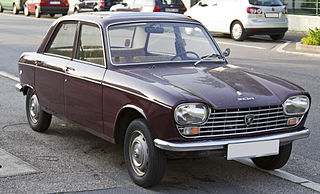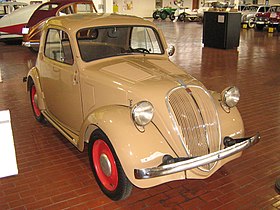
Simca was a French automaker, founded in November 1934 by Fiat S.p.A. and directed from July 1935 to May 1963 by Italian Henri Pigozzi. Simca was affiliated with Fiat and, after Simca bought Ford's French subsidiary, became increasingly controlled by Chrysler. In 1970, Simca became a brand of Chrysler's European business, ending its period as an independent company. Simca disappeared in 1978, when Chrysler divested its European operations to another French automaker, PSA Peugeot Citroën. PSA replaced the Simca brand with Talbot after a short period when some models were badged as Simca-Talbots.

The Fiat 128 is a transverse front-engine, front wheel drive small family car manufactured and marketed by Fiat from 1969 to 1985 as a two- or four-door sedan, three- or five-door station wagon as well as two- or three-door coupé. The 128 running gear and engine, reconfigured for a mid-engined layout, were used in the Fiat X1/9 sports car.

The Fiat 124 is a small family car manufactured and marketed by Italian company Fiat between 1966 and 1974. The saloon superseded the Fiat 1300 and was the basis for several variants including a station wagon, a four-seater coupé, and a two-seater convertible

The Fiat 500 is a city car that was manufactured and marketed by Fiat Automobiles from 1957 until 1975. It was sold as a two-door semi-convertible or saloon car and as a three-door panel van or estate car.
Economy car is a term mostly used in the United States for cars designed for low-cost purchase and operation. Typical economy cars are small, lightweight, and inexpensive to both produce and purchase. Stringent design constraints generally force economy car manufacturers to be inventive. Many innovations in automobile design were originally developed for economy cars, such as the Ford Model T and the Austin Mini.

The Peugeot 204 is a small family car produced by the French manufacturer Peugeot between 1965 and 1976.

The Fiat 600 is a rear-engine, water-cooled city car, manufactured and marketed by Fiat from 1955 to 1969 — offered in two-door fastback sedan and four-door Multipla mini MPV body styles. It is considered a pop icon of the Italian economic miracle.

The Fiat 1100 is a small family car produced from 1953 until 1969 by the Italian manufacturer Fiat. It was an all-new unibody replacement for the Fiat 1100 E, which descended from the pre-war, body-on-frame Fiat 508 C Balilla 1100. The 1100 was changed steadily and gradually until being replaced by the new Fiat 128 in 1969. There were also a series of light commercial versions of the 1100 built, with later models called the Fiat 1100T, which remained in production until 1971. The Fiat 1100 D also found a long life in India, where Premier Automobiles continued to build the car until the end of 2000.

The Autobianchi Bianchina is a minicar produced by the Italian automaker Autobianchi, based on the Fiat 500. It was available in various configurations: Berlina (saloon), Cabriolet (roadster), Trasformabile, Panoramica, and Furgoncino (van). The car was presented to the public on 16 September 1957 at the Museum of Science and Technology in Milan.

The Renault Juvaquatre is a small family car / compact car automobile produced by the French manufacturer Renault between 1937 and 1960, although production stopped or slowed to a trickle during the war years. The Juvaquatre was produced as a sedan/saloon until 1948 when the plant switched its full attention to the new Renault 4CV. During the second half of 1952 the plant restarted production of the Juvaquatre sedans/saloons for a period of approximately five months.

The 508 Balilla was a compact car designed and developed by Fiat in 1932. It was, effectively, the replacement of the Fiat 509, although production of the earlier model had ceased back in 1929. It had a three-speed transmission, seated four, and had a top speed of about 50 mph (80 km/h). It sold for 10,800 lire. About 113,000 were produced.

The Fiat 850 is a small rear-engine, rear-wheel-drive car manufactured and marketed by Italian car manufacturer Fiat from 1964 to 1973.

Dante Giacosa was an Italian automobile designer and engineer responsible for a range of Italian automobile designs — and for refining the front-wheel drive layout to an industry-standard configuration.

The Fiat 1400 and Fiat 1900 are passenger cars produced by Italian automotive manufacturer Fiat from 1950 to 1958 and from 1952 to 1959 respectively. The two models shared body and platform, but while the 1.4-litre 1400 was Fiat's intermediate offering, the upmarket 1900 had an enlarged 1.9-litre engine and more luxurious trim and equipment, to serve as flagship in the manufacturer's range.

The Fiat 518, also called Fiat Ardita, was a model of car produced by Italian car manufacturer Fiat between 1933 and 1938. The name "Ardita" was also used on the six-cylinder engined and more expensive Fiat Ardita 2500 or 527.

The Simca Vedette is an executive car, manufactured from 1954 to 1961 by French automaker Simca, at their factory in Poissy, France. The Vedette competed in France's large car market at a time when the economy was finally returning to growth and enjoyed moderate success with its American style finished off by the Italian designer Rapi. It was marketed with different model names according to trim and equipment levels. The Vedette was Simca's largest model at that time and it spawned a more economical version, the Simca Ariane.

The Fiat 1500 was a six-cylinder car produced by the Fiat from 1935 to 1950. It was one of the first cars tested in a wind tunnel, following the Chrysler Airflow produced one year earlier. The streamlined styling achieved an aerodynamic efficiency unequalled before it in a touring car and disproved the thesis aerodynamic cars would not sell.

The Simca 6 is a city car and van produced and sold in France by Simca from 1947 until 1950. Simca had been established as a French subsidiary of Fiat and the Simca 6 was developed from the Simca 5 which itself had been a version of Fiat’s Topolino rebadged and manufactured in France as a Simca.
France was a pioneer in the automotive industry and is the 11th-largest automobile manufacturer in the world by 2015 unit production and the third-largest in Europe. It had consistently been the 4th-largest from the end of World War II up to 2000. It is 16 % of sales of French manufactured products.

The Fiat 1100 is a small family car produced from 1937 to 1953 by the Italian car manufacturer Fiat. It was introduced in 1937 as Fiat 508 C or Balilla 1100, as a replacement for the Fiat 508 Balilla. Under the new body the 508 C had more modern and refined mechanicals compared to the 508, including independent front suspension and an enlarged overhead valve engine. In 1939 it was updated and renamed simply Fiat 1100. The 1100 was produced in three consecutive series—1100, 1100 B and 1100 E—until 1953, when it was replaced by the all-new, unibody Fiat 1100/103.





























